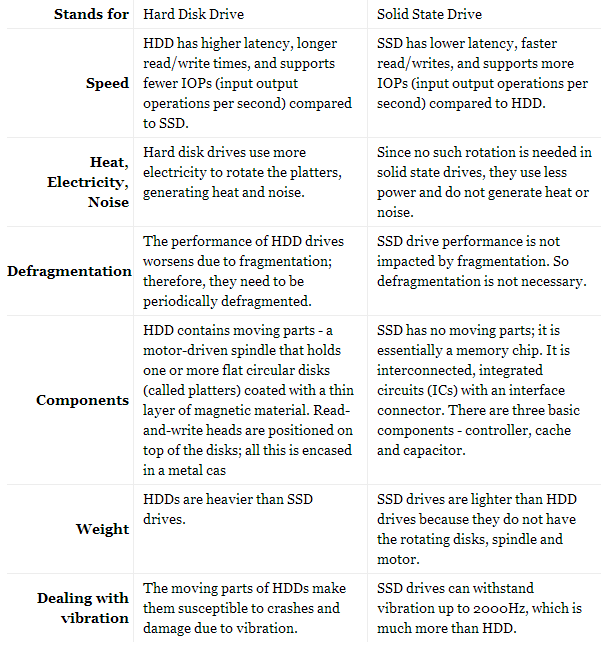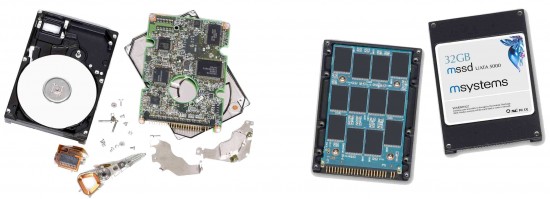A solid state drive or SSD can speed up the performance of a computer significantly, often more than what a faster processor (CPU) can. A hard disk drive or HDD is cheaper and offers more storage (500 GB to 1 TB are common, at 2014) while SSD disks are more expensive and generally available in 64 GB to 256 GB configurations.
SSDs have several advantages over HDD drives.
Comparison Chart
Speed
HDD disks use spinning platters of magnetic drives and read/write heads for operation. So start-up speed is slower for HDDs than SSDs because a spin-up for the disk is needed. Intel claims their SSD is 8 or 10 times faster than an HDD, thereby offering faster boot up times.
Benchmark statistics - small read/writes
HDDs: Small reads – 175 IOPs, Small writes – 280 IOPs
Flash SSDs: Small reads – 1075 IOPs (6x), Small writes – 21 IOPs (0.1x)
DRAM SSDs: Small reads – 4091 IOPs (23x), Small writes – 4184 IOPs (14x)
IOPs stand for Input/Output Operations Per Second.
Data transfer in an HDD vs SSD
In an HDD, data transfer is sequential. The physical read/write head "seeks" an appropriate point in the hard drive to execute the operation. This seek time can be significant. The transfer rate can also be influenced by file system fragmentation and the layout of the files. Finally, the mechanical nature of hard disks also introduces certain performance limitations.
In an SSD, data transfer is not sequential; it is random access so it is faster. There is consistent read performance because the physical location of data is irrelevant. SSDs have no read/write heads and thus no delays due to head motion (seeking).
Reliability
Unlike HDD drives, SSD disks do not have moving parts. So SSD reliability is higher. Moving parts in an HDD increase the risk of mechanical failure. The rapid motion of the platters and heads inside the hard disk drive make it susceptible to “head crash”. Head crashes can be caused by electronic failure, a sudden power failure, physical shock, wear and tear, corrosion, or poorly manufactured platters and heads. Another factor impacting reliability is the presence of magnets. HDDs use magnetic storage so are susceptible to damage or data corruption when in close proximity with powerful magnets. SSDs are not at risk for such magnetic distortion.
Power consumption
SSDs use significantly less power at peak load than traditional hard drives HDDs, less than 2W vs. 6W for an HDD. Their energy efficiency can deliver longer battery life in notebooks, less power strain on system, and a cooler computing environment.
Price
As of May 2014, SSDs are still more expensive per gigabyte than hard drives but prices for SSDs have fallen substantially in recent years. Whereas hard drives are around $0.08 per gigabyte for 3.5", or $0.20 for 2.5", a typical flash SSD is about $0.80 per GB. This is down from about $2 per GB in early 2012.
In effect, this means you can buy a 1 TB hard drive (HDD) for $80 on Amazon (see external hard drive best sellers) while the same $80 would get you a 128 GB internal SSD (see best sellers list for internal SSDs).
Defragmentation in HDDs
Due to the physical nature of HDDs and their magnetic platters that store data, IO operations (reading from or writing to the disk) work much faster when data is stored contiguously on the disk. When a file's data is stored on different parts of the disk, IO speeds are reduced because the disk needs to spin for different regions of the disk to come in contact with the read/write heads. Often there is not enough contiguous space available to store all the data in a file. This results in fragmentation of the HDD. Periodic defragmentation is needed to keep the device from slowing down in performance.
With SSD disks, there are no such physical restrictions for the read/write head. So the physical location of the data on the disk does not matter as it does not impact performance. Therefore, defragmentation is not necessary for SSD.
Noise
HDD disks are audible because they spin. HDD drives in smaller form factors (e.g. 2.5 inch) are quieter. SSD drives are integrated circuits with no moving parts and therefore do not make noise when operating.
Components and Operation
A typical HDD consists of a spindle that holds one or more flat circular disks (called platters) onto which the data is recorded. The platters are made from a non-magnetic material and are coated with a thin layer of magnetic material. Read-and-write heads are positioned on top of the disks. The platters are spun at very high speeds with a motor. A typical hard drive has two electric motors, one to spin the disks and one to position the read/write head assembly. On HDD, data is written to a platter as it rotates past the read/write heads. The read-and-write head can detect and modify the magnetization of the material immediately under it.
In contrast, SSDs use microchips, and contain no moving parts. SSD components include a controller, which is an embedded processor that executes firmware-level software and is one of the most important factors of SSD performance; cache, where a directory of block placement and wear leveling data are also kept; and energy storage - a capacitor or batteries - so that data in the cache can be flushed to the drive when power is dropped.
The primary storage component in an SSD has been DRAM volatile memory since they were first developed, but since 2009 it is more commonly NAND flash memory. The performance of the SSD can scale with the number of parallel NAND flash chips used in the device. A single NAND chip is relatively slow. When multiple NAND devices operate in parallel inside an SSD, the bandwidth scales, and the high latencies can be hidden, as long as enough outstanding operations are pending and the load is evenly distributed between devices.




